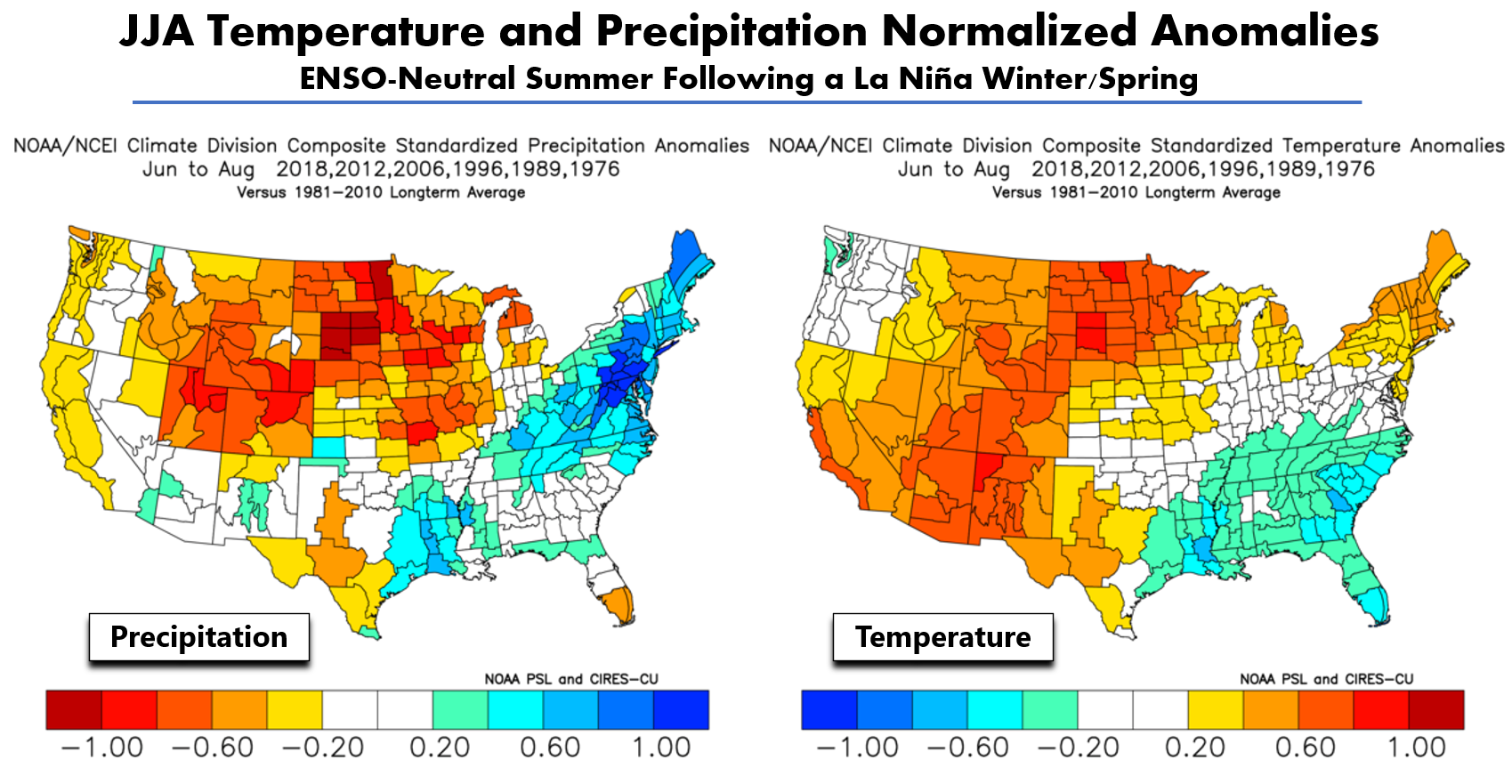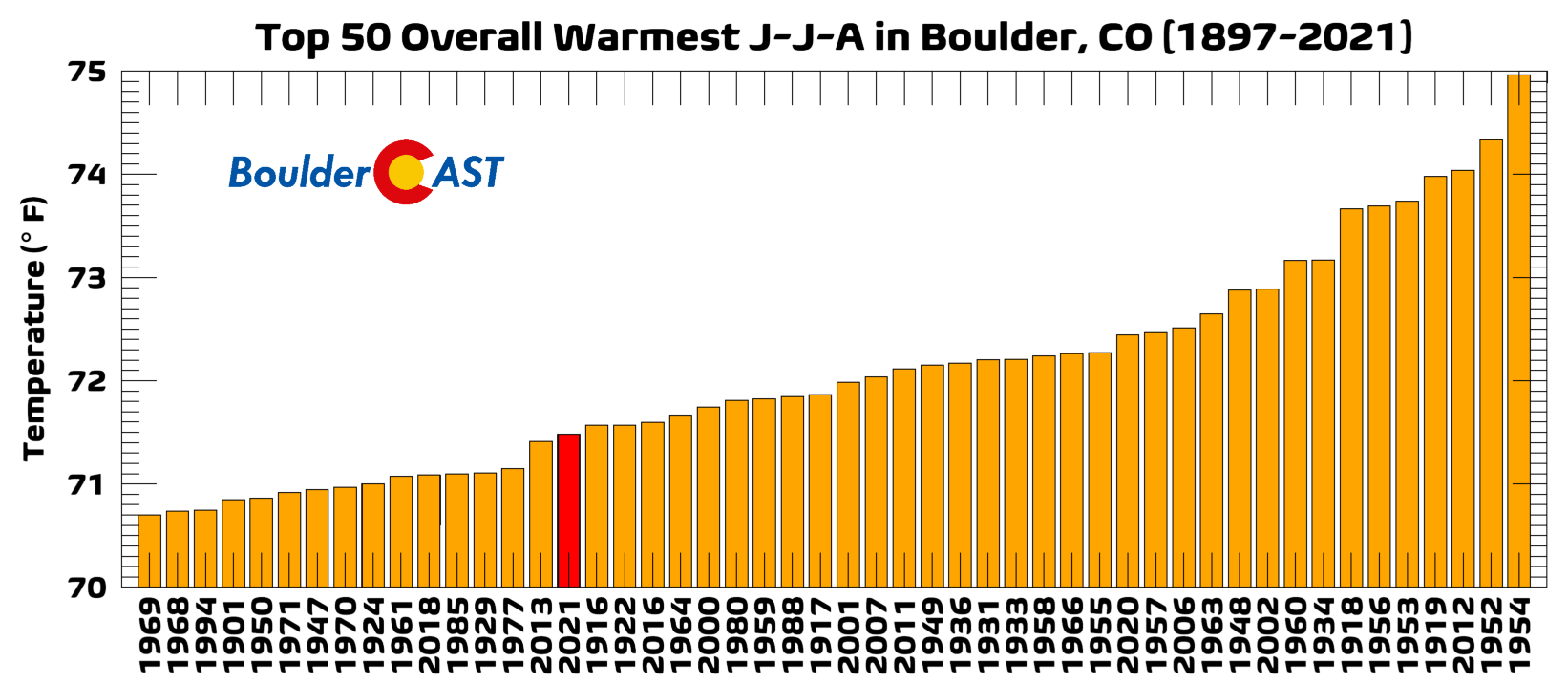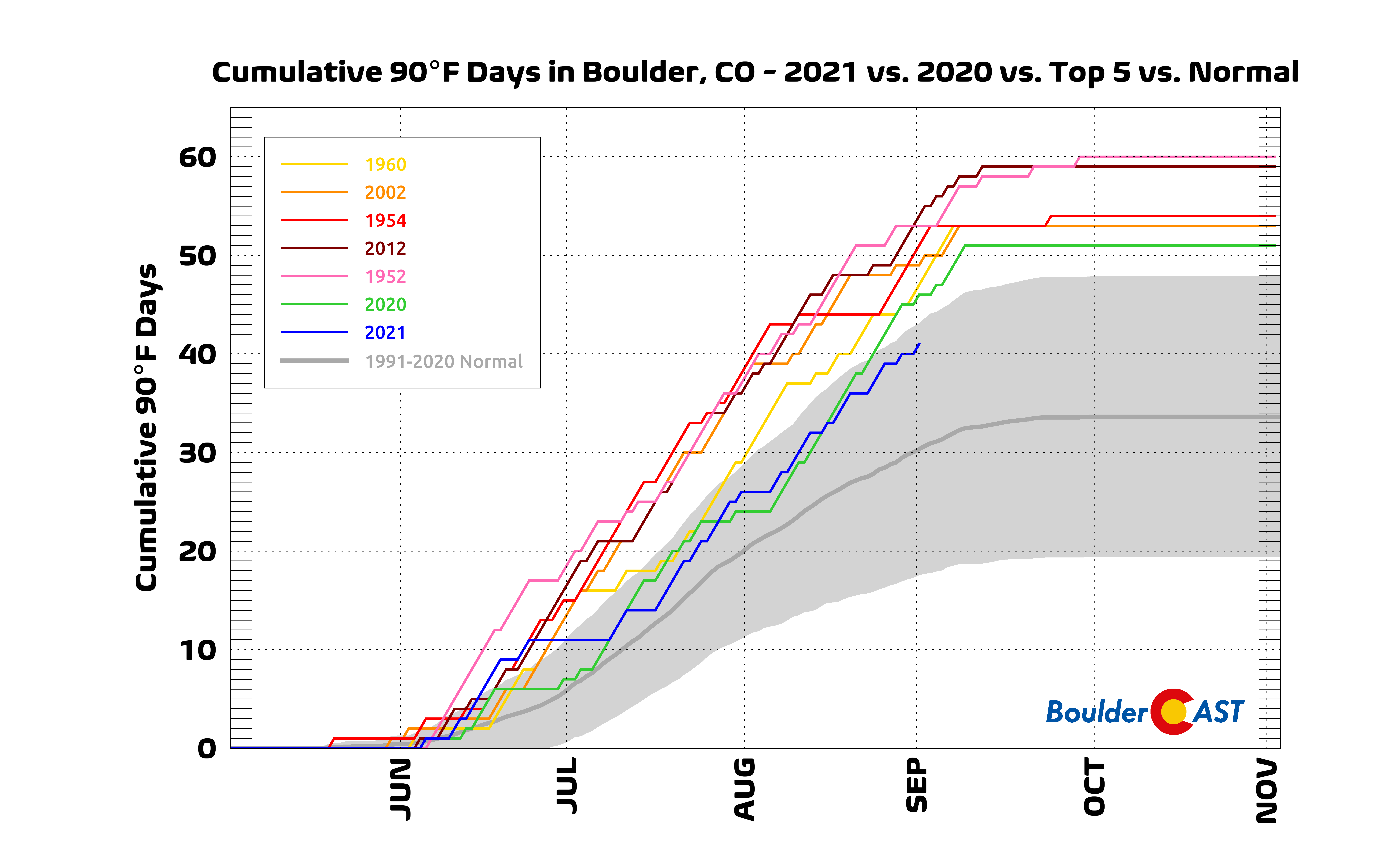Meteorological summer begins on June 1st and runs through August 31st. With that end date now having come and gone, the official numbers are in for Summer 2021! Let’s take a look at how Boulder, Denver and Colorado as a whole did this summer in terms of temperatures and precipitation. We also check in on how our state fared compared to the rest of the country. If you like seeing data displayed on graphs and maps, this post is for you!
Key Highlights from This Post:
- The summer ended warm and dry for much of the western and northern tiers of the country which was right in-line with our outlook
- Summer 2021 was Colorado’s 4th warmest and 33rd driest in the historical record
- Northwest portions of the state had a record hot summer, while northeast Colorado had a record dry one
- Boulder was a bit of an outlier: it was warmer than normal, but not exceptionally so, and also it had above normal rainfall
- Drought has improved slightly across the Western Slope, but has unfortunately returned to northeast Colorado
Help support our team of Front Range weather bloggers by joining BoulderCAST Premium. We talk Boulder and Denver weather every single day. Sign up now to get access to our daily forecast discussions each morning, complete six-day skiing and hiking forecasts powered by machine learning, first-class access to all our Colorado-centric high-resolution weather graphics, bonus storm updates and much more! Or not, we just appreciate your readership!
I
n general, the northern and western tiers of the United States experienced warmer and drier than normal conditions this summer. Unrelenting heat was observed much of the time across the Pacific Northwest in particular. The cherry on top was the record-shattering heatwave that impacted that area in late June, killing more than 500 people. Portland and Seattle both set new all-time record high temperatures on June 28th at 116°F and 108°F, respectively. These readings are some 40°F above normal for those typically cooler coastal locations. Can you imagine if we saw temperatures 40°F above normal here in Denver in late June? We’d be sizzling at near 130°F, close to the existing record high for planet Earth! California and the Pacific Northwest were very dry, perhaps a foreshadow to the explosive fire season we have seen unfold in that area all summer long. Southern Arizona was quietly slammed by an intense monsoon season with many cities like Tucson shattering existing rainfall records, while Alabama and Mississippi were flooded with heavy rains from Hurricane Ida in late August. This summer had a little bit of everything!
The overall outcome across the country didn’t land too far from our summer outlook based on historical analogs for an ENSO-Neutral summer following a La Niña winter. There are a lot of similar patterns visible in the observations (above) with our analog forecast (below).

Focusing in more on just Colorado, we see that our state landed on the warm and dry end of the spectrum. Eastern Colorado was the driest in the state having had a devastatingly meager monsoon season. We talked about this many times, but the flow of monsoonal moisture rarely lined up with the Front Range or eastern Colorado. Portions of the Mountains did register above normal rainfall this summer (hooray!), but it wasn’t enough to eradicate the ongoing drought there. It more or less just kept the existing drought from further expanding with maybe some slight improvement, which we should consider a win in this scenario!
Nearly the entire state reported above normal temperatures for the summer as a whole, with the exception of a small fraction of southeast Colorado which was closer to normal. The northwest corner of the Centennial State was the most anomalously warm (+3-7°F), but the Front Range was not far behind (+1-4°F). This spatial data suggests that many areas across northwest Colorado had their hottest summer ever on record (below right; red shading) while at the same time, portions of northeast Colorado had their driest summer on record (below left; red shading).
The map above highlights some variation in precipitation across the Front Range, with even some slightly above normal precipitation noted in portions of Boulder County. This was mainly due to a highly localized flooding thunderstorm that hit the city of Boulder in late July but also a stretch of soaking rains in late June. Denver, however, was not as lucky with just 1.45″ of total rainfall during the summer which is of course pathetic and amounts to just 25% of what we would normally expect to fall in any given summer season. Summer 2021 was Denver’s 5th driest on record:
DENVER’S TOP 5 DRIEST SUMMERS
- 0.77″ (1941)
- 0.81″ (1924)
- 1.08″ (1939)
- 1.22″ (1940)
- 1.45″ (2021)
The seemingly never-ending heat this summer was just officially confirmed by NOAA’s National Climatic Data Center. As a whole, Summer 2021 was the 4th warmest in Colorado state history since 1895. The temperature anomalies for June, July and August are shown below.
This all breaks down to 2021 being the hottest summer on record in four Colorado counties. Most Front Range locales ended up with a Top 5 or Top 10 warmest summer. It’s good to get this confirmation because it sure did feel like it! Temperature rankings by county across the state are shown below. Note that a rank of 127th is the hottest summer on record. Lower ranks trend cooler.
What about in Boulder specifically? Well, June by far was our month with the greatest warm anomalies, particularly early and mid-June. We had a week long period of cool and rainy weather in late June. At least that’s what are graphic shows. Does anyone even remember that at this point!? At the time, we didn’t know this would sadly be the last of such weather for the entire summer. After July 7th, a majority of days were warmer than normal, with the mean temperature anomaly in Boulder for the entire summer landing at +1.3°F.
Remarkably, Summer 2021 concluded as the city of Boulder’s 35th warmest dating back to 1897. As hot as it felt at times, it didn’t even beat 2016, 2012 or even last year! Part of this temperature ranking discrepancy between the city of Boulder and Boulder County comes down to the reporting of overnight low temperatures. The official Boulder observation is notoriously colder on most nights than any surrounding weather observations across the rest of the city.
There were 41 90-degree days this summer in Boulder. While certainly above average, 2021 doesn’t hold a candle to some of the hottest summers of the past. Heck, even last year had 46 90-degree days by the end of August.
Let’s move on to the rain! Precipitation rankings indicate southwest Colorado had a fruitful early summer (June and July), while northwest Colorado picked up good moisture in August. Areas from Denver eastward were generally drier than normal all summer long, with ten counties in eastern Colorado notching a Top 10 driest summer. As mentioned earlier, the city of Denver (i.e. DIA) reported its fifth driest summer. This extended period of limited rainfall has fueled a return of drought conditions in recent weeks to the Eastern Plains.
Boulder was one of the few Front Range bright spots that managed to ink out a wetter than normal summer, but again, that was only due to a couple lucky days of heavy rainfall.
Overall, the warm and dry summer leaves Colorado in a tough place again heading into autumn. Drought or abnormally dry conditions now encompass 53% of the state, up from 42% at the start of summer. The aspen trees in the mountains are already starting to change color, many going straight to brown under the stress of drought. Peak fall foliage is definitely going to be a bit early this year, so do plan accordingly if you want to peep some leaves.
That’s a wrap for Summer 2021! For more specific details on the weather during each month during the summer, check out our monthly summary posts below.
Stay up to date with Colorado weather and get notified of our latest forecasts and storm updates:
We respect your privacy. You can unsubscribe at any time.
Help support our team of Front Range weather bloggers by joining BoulderCAST Premium. We talk Boulder and Denver weather every single day. Sign up now to get access to our daily forecast discussions each morning, complete six-day skiing and hiking forecasts powered by machine learning, first-class access to all our Colorado-centric high-resolution weather graphics, bonus storm updates and much more! Or not, we just appreciate your readership!
.




















You must be logged in to post a comment.